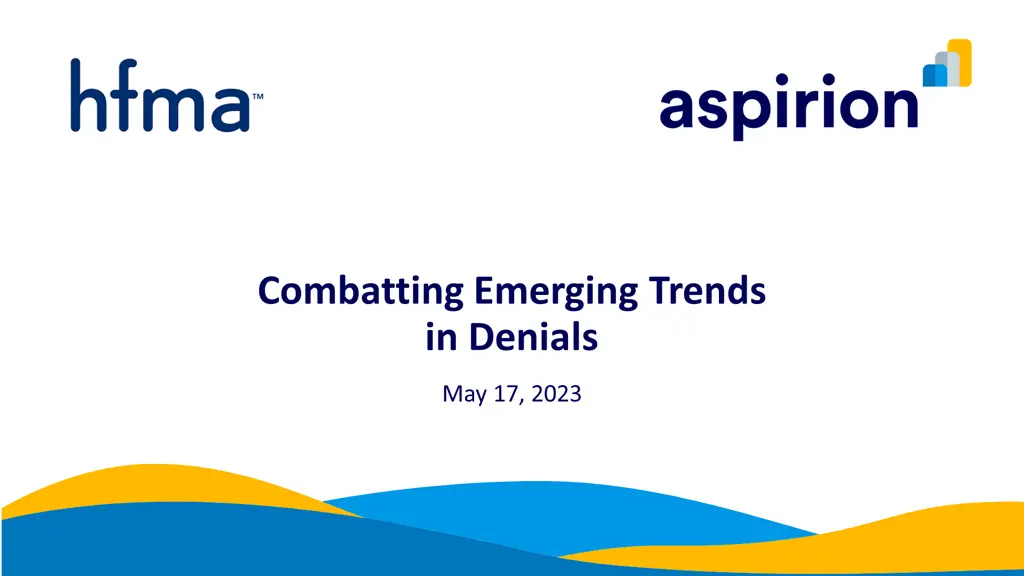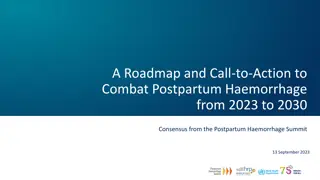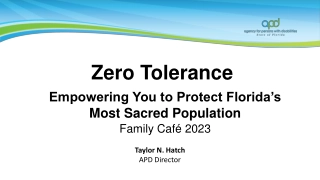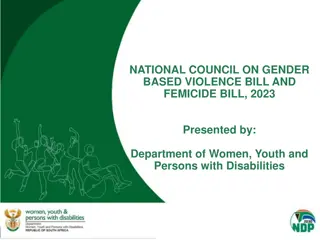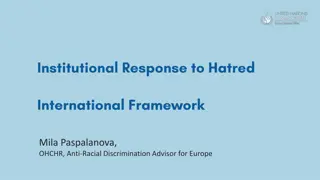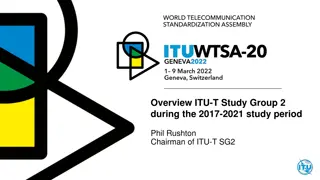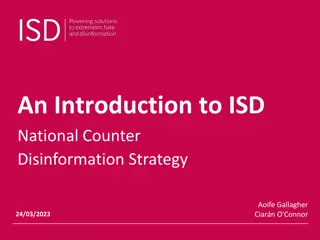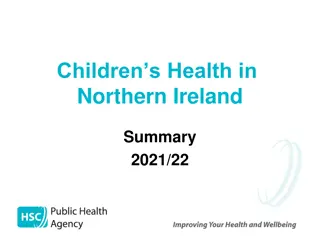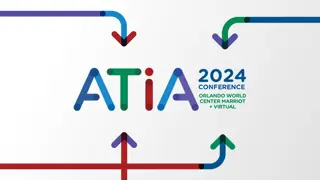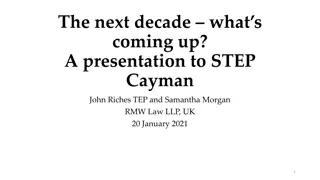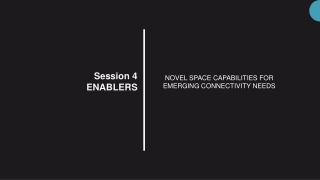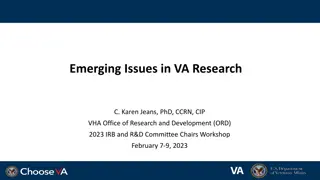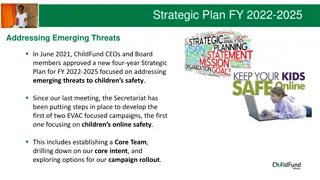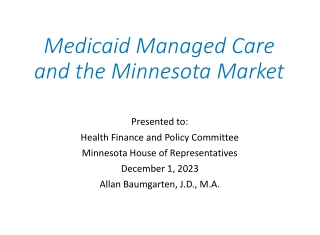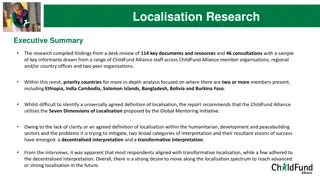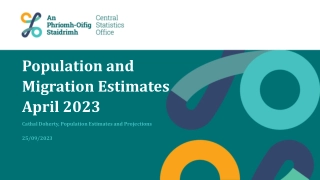Combatting Emerging Trends in Denials
Strategies to combat emerging trends in denials, including increasing denials across the country and issue identification. Gain insights into rules, rationales, analysis, and application to increase your success in appeals.
Download Presentation

Please find below an Image/Link to download the presentation.
The content on the website is provided AS IS for your information and personal use only. It may not be sold, licensed, or shared on other websites without obtaining consent from the author. Download presentation by click this link. If you encounter any issues during the download, it is possible that the publisher has removed the file from their server.
E N D
Presentation Transcript
Combatting Emerging Trends in Denials May 17, 2023
Agenda 1 Denials Increasing Across the Country 2 Issue Identification 3 Rules and Rationales 4 Analysis and Application 5 Conclusion
Todays Clinical Denials Landscape Clinical denials have increased, particularly complex denials. Over the last 5 years, Aspirion has seen a 15%-20% average increase in clinical denials including: Authorization, Medical Necessity, Inpatient to Outpatient Downgrades, ED Acuity Level Downgrades, etc. 15-20% AVERAGE INCREASE IN CLINICAL DENIALS
Aspirion Denial Category Trends Rising Denial Categories No Authorization Medical Necessity DRG Validation
Access Documentation Timing of Inpatient Order The patient can be treated at a lesser level of care. Physician Rationale Peer-to-Peer Review Clinical Guidelines Utilized Health Plan Inpatient authorization denied at time of request Documentation Quality Communication/Process Issue
Access Documentation Physician Rationale Was physician rationale for inpatient admit clearly documented? Timing of Inpatient Order Physician Rationale Peer-to-Peer Review 40% Clinical Guidelines Utilized 60% Documentation Quality Communication/Process Issue No Yes
Access Documentation Clinical Guidelines Utilized 1. Payer used IQ for General Trauma Patient had no injury within 24 hours of admit Timing of Inpatient Order Physician Rationale 2. Payer used chronic renal failure criteria Patient was admitted with heart failure Peer-to-Peer Review Clinical Guidelines Utilized 3. Payer used IQ for Adult General Medicine Patient met under IQ for Diabetic Ketoacidosis Documentation Quality Communication/Process Issue
Agenda 1 Denials Increasing Across the Country 2 Issue Identification 3 Rules and Rationales 4 Analysis and Application 5 Crafting an Effective Appeal
Principles of Appeal Drafting: Issue Identification Overlying Goal: To submit a well-drafted, tailored appeal that will yield favorable resolution. Steps to Take for Issue Identification: Carefully review the history of the account and payor correspondence(s). Contact the Payor for additional information or clarification. Ask specific and pointed questions narrowly tailor the reasons why. Ensure that you are speaking with the correct department/entity. Remember to contact the authorization department, too. Do not assume that the claims department is giving you the correct and/or complete information. Request a copy of the denial letter. Additional Research, if required per the denial type Experimental, non-covered services, vague denials, coding issues
Principles of Appeal Drafting: Issue Identification Appeals must be narrowly tailored to the claim s specific denial type. Denial Example: Claim was denied due to lack of authorization Broad denial reason what is the argument? Are we sure it s the right argument? A. Non-Compliance/Procedural/Technical Authorization Denials i. No Authorization was Requested. ii. Authorization was requested, but the authorization request was late. iii. Authorization was requested, but for a substantially similar procedure. B. Medical Necessity/Clinical Authorization Denials i. Authorization was requested, but the level of care and/or service was deemed not medically necessary (level of care denial). ii. Authorization was requested, and partially approved, but the claim s date of service exceeds the approved units of authorization (length of stay denial).
Principles of Appeal Drafting: Issue Identification Depending on whether the root of the denial is due to (A) or (B), the argument stated in the appeal changes A. Non- Compliance Authorization Denial The crux of this denial is the facility s failure to request authorization as required by the payor s authorization guidelines. The first argument must address the non-compliance/procedural/ technical denial explaining why authorization wasn t requested. The second argument must address the clinical rationale. B. Medical Necessity Authorization Denials The crux of this denial is payor s failure to agree with the level of care/service that the facility provided to the patient The central argument for this denial type is a Medical Necessity Argument for the level of care/service provided
Case Study Issue Identification Newborn baby claim with dates of service 6/1/2022-9/1/2022. Baby immediately placed in the NICU for respiratory distress and suspected esophageal fistula. Total charges of $1,500,000 and an Expected Reimbursement of $900,000. Primary insurance is Highmark BCBS and secondary is AmeriHealth Medicaid. The claim initially denied as out of network. There are approved authorizations for the complete services by both Highmark and AmeriHealth. What is/are the issue(s)? No out of network coverage? Authorization? Invalid or denied? Medical Necessity Issues? Initial Appeal submitted and denied
Agenda 1 Denials Increasing Across the Country 2 Issue Identification 3 Rules and Rationales 4 Analysis and Application 5 Crafting an Effective Appeal
Rules and Rationales Medical reviewers must only consider the medical evidence that was available to the physician at the time he or she made the admission decision (i.e., what is known & knowable ). Medicare Advantage Plans may not restrict a patient s benefits beyond the limitations imposed by Traditional Medicare. Section 10.2 Medicare Managed Care Manual Reviewers are instructed NOT to take into account other information, such as test results, that was not available to admitting physician unless it would support the admission decision. Benefits Policy Manual (CMS Pub. 100-02), Ch. 1, 10
Rules and Rationales Regulatory Arguments Use of Incorrect Clinical Criteria Health Plans often use Milliman Care Guidelines ( MCG ) or InterQual criteria to deny inpatient Medicare Advantage Plan claims. Inpatient admissions for Medicare Advantage beneficiaries must be reviewed under the two-midnight rule with deference to the physician s complex medical judgement. According to CMS, criteria such as InterQual and MCG are just tools, not Medicare policy. What does your contract say?
Clinical Denials: Common Payer Trends As a rule of thumb, authorization denials will have an underlying medical necessity issue. I.e. Payers will deny the level of care rendered or will deny the length of stay. Payers may target accounts with certain symptom or diagnosis codes (i.e., chest pain, shortness of breath, syncope) for denial review Payers may use wrong criteria to assess the medical necessity of the admission Commercial: InterQual & Milliman Care Guidelines ( MCG ) Medicare: Two Midnight Rule Payers may limit review to one condition when the patient has multiple conditions that could be evaluated against the criteria
The Unique Patient Courts have stated the term medical necessity must refer to what is medically necessary for a particular patient. Where an insurer presents sufficient evidence to show that a treatment is not medically necessary in the usual case, the burden shifts to the patient/provider to show that this individual patient is different from the usual in ways that make the treatment medically necessary for him or her. 17
Case Study Rules and Rationales No out of network coverage and Authorizations Was authorization provided and what does that even mean? If there was a network issue it should have been identified and addressed during the authorization process Provider Contract Is there a network agreement between provider of service and the payor? Were the services provided emergent in a nature or otherwise medically supported? External Supporting Information Federal and State Statutory support Are the Federal or State Statutes which support the coverage determination? Are the Federal or State Statutes which support the medical necessity of the services?
Agenda 1 Denials Increasing Across the Country 2 Issue Identification 3 Rules and Rationales 4 Analysis and Application 5 Crafting an Effective Appeal
Medical Necessity Argument Medical Records Do s and Don ts Do: Refer to how long the symptoms have been going on for and what other treatments have been tried Include abnormal testing results that impact why the patient needed the care Use the right portions of the record for the denial you have Proper timeframe reference Don t: Regurgitate the medical records Include testing results that don t impact the patient s treatment Include information that could hurt your argument
Medical Necessity Argument: Commercial Argue the admission met inpatient criteria based on the information known and knowable to the physician at the time the decision was made. We disagree that UHC can override and ignore the assessment and plan of the healthcare providers who were directly involved in caring for this patient and devise a new plan for her at its discretion; solely based on paper documentation, without physical examination and direct involvement with the patient. The decision to admit was made by a licensed provider, and required complex medical judgment based on comprehensive knowledge and understanding of the bedside care essential for this patient to have a successful outcome. Great deference must be given to the treating physician and the information available at the time of the decision to admit; a retrospective review is not permissible.
Contractual Medical Necessity Argument Example: Health Net Contractual Definition of Medical Necessity Medically Necessary or Medical Necessity: Those Covered Services which, under the provisions of this Agreement, are determined to be: Appropriate and necessary for the symptoms, diagnosis or treatment of a condition, illness or injury; and Provided for the diagnosis or the direct care and treatment of a medical condition, illness or injury; and Within the standards of good medical practice within the organized medical community; and Not primarily for the convenience of the member, or the Member s physician or other provider; and The most appropriate supply or level of service, including levels of acute care such as ICU services or regular acute medical and surgical services as determined by the clinical status of the Member, which can safely be provided to the member. For hospitalization, this means that the Member requires acute care as an inpatient due to the nature of the services the Member is receiving, or the severity of the Member s condition, and that safe and adequate care cannot be received as an outpatient or at a less intensified medical setting such as a sub-acute unit or Skilled Nursing Facility.
Contractual Medical Necessity Argument Example: UHC Contractual Definition of Medical Necessity
Contractual Medical Necessity Argument Example: Humana Contractual Definition of Medical Necessity
Medical Necessity Argument: Medicare Medicare criteria for medical necessity is based on Medicare Policy Manuals Local Coverage Determinations ( LCD ) National Coverage Determinations ( NCD ) Medicare Level of Care Determinations Two Criteria: The Two Midnight Rule Admission was Medically Necessary and Reasonable
Medical Necessity Argument: Commercial Inpatient Only Procedures Apply similar argument for non-Medicare claims The country s largest payer of healthcare services (i.e., the Federal Government) deemed these procedures so serious that the surgeries must be performed at a hospital on an inpatient basis. Payer must cover services provided in accordance with the generally accepted standards of medical practice. However, Payer s determination that this surgery should have been performed on an outpatient basis is in direct conflict with generally accepted standards of medical practice as evidenced by CMS s designation of this surgery as in inpatient procedure. *Note, some Commercial payers may have a provision in their contract stating that the payor must pay per the IP list. As such, a good reminder to check through the contract!
Case Study Analysis and Application No out of network coverage and Authorizations Both Highmark BCBS and AmeriHealth Medicaid provided approved authorizations If there was a network issue it should have been identified and addressed during the authorization process Provider Contract Policy documents state all emergency care and services out of network with authorizations would be reimbursed, and provider is in-network Estoppel and Detrimental Reliance the legal principles which excludes the assertion of a contrary position to the position that is implied by prior action they authorized the claim, the facility relied on that authorization in providing services, and should be compensated appropriately. External Supporting Information Federal and State Statutory support Newborn and Mother s Health Protection Act (NMHPA 1) group health can t restrict benefits for childbirth to less than 96 hours for cesarean Affordable Care Act (ACA) Maternity care is covered as an essential health benefit PA Sate Act: 1975 Act 81 1-3 Insurers required to provide coverage for treatment of medically diagnosed congenital defects, birth abnormalities, prematurity, and routine nursery care
Agenda 1 Denials Increasing Across the Country 2 Issue Identification 3 Rules and Rationales 4 Analysis and Application 5 Crafting an Effective Appeal
Appeal Components Header Background Procedural Arguments Contractual Arguments Medical Necessity Closing Summary & Plea for Payment
Appeals Approach: Procedural Arguments Denied requests may involve issues in addition to lack of medical necessity that must be overcome prior to addressing medical necessity Procedural Issue Example: Invalid Authorization Often, there is a valid reason for failure obtain valid authorization: The patient presented to the emergency department unconscious and could not communicate coverage information; The patient did not have an insurance identification card upon presentation to the emergency department; The patient indicated coverage under traditional Medicare. The hospital attempted to obtain authorization, however, when the hospital called the carrier, the carrier advised that authorization was not required
Appeals Approach: Contract Argument The Hospital s managed care contract may contain language which supports your procedural argument For example: UHC contract provision which excuses untimely authorization requests or untimely submission of a claim if the facility can show that at the time the notification or submission was required, the facility was unaware and unable to reasonably determine that the patient was a UHC member.
Appeals Approach: Contract Argument Example: Health Net Contractual Definition of Medical Necessity Medically Necessary or Medical Necessity: Those Covered Services which, under the provisions of this Agreement, are determined to be: Appropriate and necessary for the symptoms, diagnosis or treatment of a condition, illness or injury; and Provided for the diagnosis or the direct care and treatment of a medical condition, illness or injury; and Within the standards of good medical practice within the organized medical community; and Not primarily for the convenience of the member, or the Member s physician or other provider; and The most appropriate supply or level of service, including levels of acute care such as ICU services or regular acute medical and surgical services as determined by the clinical status of the Member, which can safely be provided to the member. For hospitalization, this means that the Member requires acute care as an inpatient due to the nature of the services the Member is receiving, or the severity of the Member s condition, and that safe and adequate care cannot be received as an outpatient or at a less intensified medical setting such as a sub-acute unit or Skilled Nursing Facility.
Appeals Approach: Medical Necessity Arguments Once the procedural issue is addressed, the appeal must then establish the medical necessity of the treatment Argue the admission meets inpatient criteria based on the information known and knowable to the physician at the time the decision was made Address situations in which the payer utilized the incorrect MCG/InterQual Criteria
Effective Level of Care Appeals Get the denial letter! Provides the clinical rationale used to deny the claim Dispute their findings directly with the medical record documentation Cite specific medical necessity criteria InterQual or Milliman Care Guidelines Add risk stratification to your argument Example: Comorbid conditions being treated concurrently that increased the risk of the patient for possible complications or deterioration of patient s condition
Case Study Crafting an Effective Appeal Authorization For Services Was Obtained These services are for a newborn born on 06/01/2022 at HOSPITAL. Highmark was notified of the baby s delivery and authorization was requested. Highmark provided authorization # Case-111111, see enclosed case management notes. HOSPITAL and Highmark corresponded every couple of days to extend the authorization throughout the entire date of service. The patient was also authorized for transfer on 8/21/2022 to Second Hospital. During this time, Highmark never mentioned the patient was out-of-network or requested the patient be transferred instead of receiving care.
Case Study Crafting an Effective Appeal Services are Protected Federally and by the State of Pennsylvania As noted above, these services were for a newborn and are therefore protected federally and statutorily in the State of Pennsylvania. Notably, per NMHPA, group health plans and health insurance issuers may NOT restrict benefits for a hospital stay in connection with childbirth to less than 48 hours following a vaginal delivery or 96 hours following a delivery by cesarean section. Moreover, per ACA, emergency and maternity care is covered as an essential health benefit. The patient required additional NICU care and could not be safely discharged or transferred until stable. Under Pennsylvania law health insurers are required to provide coverage with respect to a newborn child. The coverage shall consist of coverage of injury or sickness including the necessary care and treatment of medically diagnosed congenital defects, birth abnormalities, prematurity and routine nursery care, but need not include routine well-baby care, immunizations and medical examinations or tests not necessary for the treatment of a covered injury, illness, defect, deformity or disease except to the extent that such coverages are provided the insured or for dependent children under the same class of coverage . These services are required to be rendered and covered by health insurers under the above statutes. Therefore, HOSPITAL demands processing of this claim for payment.
Case Study Crafting an Effective Appeal HOSPITAL is a Contracted Provider with Highmark Per the eligibility checks run during the patient s stay, Highmark was a valid policy. Per HIPAA, as long as a newborn is enrolled on the mother s plan within 30 days of birth, coverage is effective as of the birth date. This patient was added to the policy and the policy remained in effect through the end of the year. HOSPITAL has an active contract with Highmark and is in network. Even if Highmark determined this particular plan was not in network, the policy documents state all emergency care and services out of network with authorization would be reimbursed. As noted above, services were fully authorized. Lastly, per the Highmark Sapphire Digital site, HOSPITAL is in-network.
Case Study Crafting an Effective Appeal Services Were Medically Necessary The patient is a newborn, born at 39 weeks by C-section, with a weight of 3271 grams. The patient was immediately placed in the NICU for respiratory distress and suspected esophageal fistula. The patient required care for sepsis, respiratory distress, hypoxemia, tachypnea and TEF. The patient underwent repair of the esophageal atresia and tracheoesophageal fistula on 06/24/2022. She required intubation and mechanical ventilation. She was unable to extubated until 08/10/2022 and 08/12/2022, she was noted to have severe tracheomalacia and a type III laryngeal cleft. The patient had persistent reflux and emesis, leading to G-tube placement. Moreover, the patient was treated for MSSA infections and pneumonia during the stay. Eventually, the patient was transferred via LifeFlight to Second Hospital. There is no question these services were medically necessary, and they were fully authorized by Highmark. Nonetheless, the medical records are included for review.
Case Study Crafting an Effective Appeal Conclusion Highmark should reimburse these services under the legal theory of detrimental reliance. HOSPITAL notified Highmark, received authorization, continued to verify eligibility, and provided medically necessary services. HOSPITAL was never informed of any issues regarding the patient s services. HOSPITAL relied on Highmark to their detriment. Highmark is in the best position to know whether services require authorization or are out of network. HOSPITAL attempted to comply with Highmark by obtaining authorization. HOSPITAL should be compensated for the services provided to the Highmark member. It is clear that the services performed were medically necessary and protected by state and federal legislation. Therefore, HOSPITAL requests review and reimbursement of the above claim.
Case Study RESULTS! What if none of that works? Multiple appeals denied! What s in your toolbox? Escalate, escalate, escalate Provider reps JOC Meetings General Counsel This account needed escalation through all of the above Ultimately resolved through several emails/phone calls with Highmark s GC $900,000 recovered!
Appeal Writing Tips Place the most compelling argument and information at the beginning of the appeal Don t just state the services were medically necessary. Use facts from the medical records, not just generalities Avoid including information that is inconsistent with your argument Keep the reviewer focused on the right information make it easy for them to approve
Dave Jewell, JD MBA Managing Attorney & Executive Director, Client Success Direct: (540) 664-6150 dave.jewell@aspirion.com Thank you
